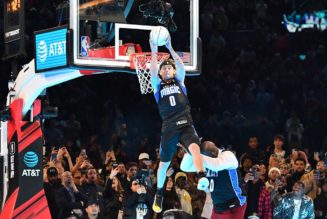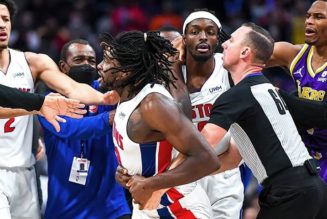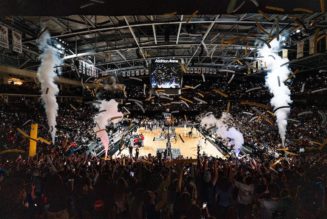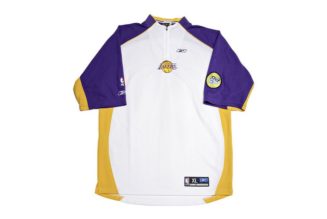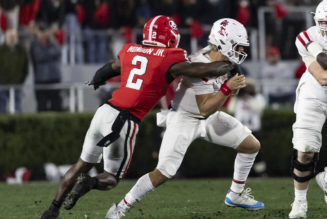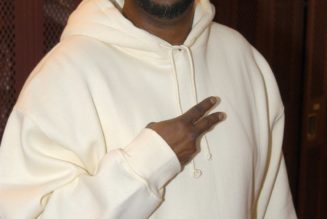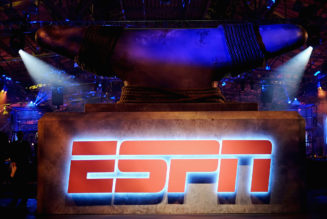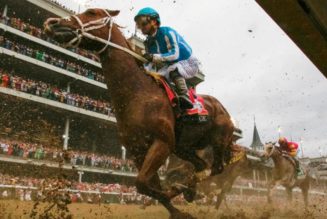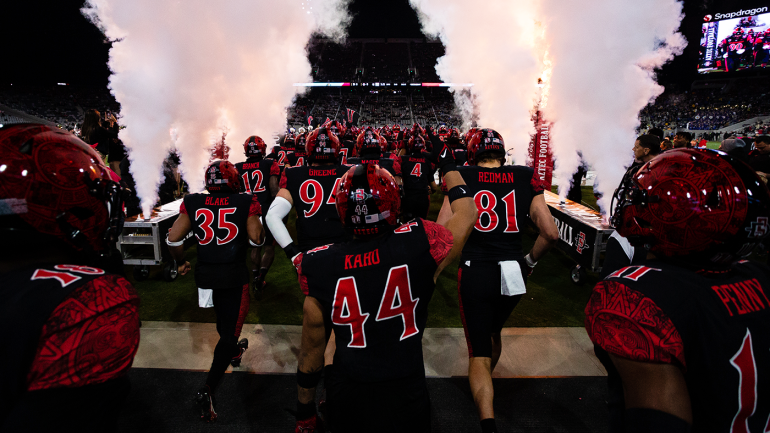
SAN DIEGO — J.D. Wicker is standing on the top concourse of one of the biggest parties in the country. What else would you call San Diego State’s new stadium, which equates to the latest lob pass for what the school hopes is a slam-dunk entry into the Pac-12?
On its best day, which projects to be every game day, college football is almost a sideshow in new Snapdragon Stadium. The main event is the craft brew-infused vibe that San Diego State’s athletic director has, well, crafted.
“There are more bars in that stadium than there are in most cities,” said Aztecs coach Brady Hoke.
That isn’t entirely why San Diego State enters 2023 as the next hottest realignment candidate, but elite concessions certainly do not hurt. Taps or no taps, Wicker’s vision of a 35,000-seat boutique stadium reflecting the city’s culture, history, food and brew — built on one of the country’s most expensive pieces of real estate — was going up regardless.
Snapdragon opened last year on time and under budget — rebranding, renewing and rallying a 126-year-old institution. At the same time, in and around “America’s Finest City,” the planets have (re)aligned. When USC and UCLA left for the Big Ten, San Diego State in a flash became the best, brightest, most geographically desirable school to fill what is now a gaping hole in Southern California for the Pac-12.
After years of priming itself in hopes the West Coast’s flagship conference would notice, SDSU doesn’t have to flirt anymore. The moment has met SDSU, roaring down I-5 from Los Angeles to meet the school on what seems to be the Aztecs’ terms.
“We basically went from, ‘Hey, you’re doing a good job. Your break is coming,’ to, ‘You’re the only team in Southern California that plays FBS football that isn’t in the Big Ten,'” Wicker said.
The mood floating around Cali’s second largest — but still laidback — city is split between breathless anticipation and trying not to get too emotionally invested. Dreams have been dashed here before. See: The Chargers following the 2016 season.
“It’s not an if, it’s a when,” said a high-ranking industry source regarding SDSU’s future opportunity to join the Pac-12.
“Now that USC and UCLA are gone, there’s nobody really to block us,” said Jack McGrory, an SDSU alumnus, professor on campus for 25 years and now a member of the California State University board of trustees. “We’re the only viable option to have a team in Southern California.”
Still, this being realignment, there are never any guarantees.
“Once the ink is dry, so they say, then we celebrate,” warned David Malcolm, a real estate tycoon in the area for half a century who helped arrange the $15 million lead donor gift for Snapdragon.
Officially, the Pac-12 has said it will consider expansion once it signs a new media rights deal.
Sources tell CBS Sports that deal is expected to be made in the first quarter of 2023 with Amazon (or another streaming service) and ESPN. Expansion would follow. Regardless, it must happen fast with USC and UCLA leaving for the Big Ten in 2024.
Unofficially, there is an assumption in the industry the Pac-12 has no choice but to plug up its Southern California hole with SDSU.
“People in this town will lose their mind if, in the same academic year, they get a brand new football stadium and San Diego State goes into the Pac-12,” Wicker said.
Wicker, 53, was already considered one of the industry’s more influential ADs. He recently spoke with Mississippi State, his alma mater, about its vacant AD job before the school hired Oklahoma deputy AD Zac Selmon. But if things progress as planned, Wicker might become a Power Five AD by staying put.
Now, about that beer. Wicker fundraised for a $310 million stadium that would take $800 million to build today, according to Malcolm. Wicker wanted the entire experience to reflect the city, its weather (driest on the West Coast), its fish tacos (best anywhere) and its essence.
“I wanted you to know you’re in San Diego State’s football stadium, but I didn’t want to throw up San Diego State on everything,” Wicker explained.
“Pac-12 folks have been impressed with what we’ve done. [Pac-12] commissioner George Kliavkoff said to invest in football. I have a $310 million investment.”
That means paying homage to San Diego’s craft beer heritage. San Diego County, the “Capital of Craft,” boasts 150 breweries. Wicker went further in Snapdragon, saluting with images ranging everywhere from the school’s six-legged Wampus Cat mascot in the 1920s to the San Diego Chicken.
There are even piers (with beers) in the stadium.
Snapdragon was designed to expand to 55,000 seats and potentially host an NFL franchise, which would heal a wound opened when the Chargers left for Los Angeles.
“The NFL actually knows our stadium, knows our design. J.D. thought of everything,” Malcolm said.
As for the relatively small capacity of Snapdragon, sure, the Rose Bowl is more than 2.5 times larger. But Washington State’s Martin Stadium in the Pac-12 is smaller, and Oregon State’s Reser Stadium is slightly larger. Besides, with attendance declining nationally, plenty of ADs would kill to fit demand by building an on-campus stadium from the ground up.
San Diego is a top 30 market. Not the No. 2 market as Los Angeles can claim but still a stake in the Southern California ground. Wicker commissioned a study that showed there are approximately 250 FBS prospects from Santa Barbara south. That doesn’t mean the Aztecs will get them all, but the school does have some leverage.
“You want San Diego State in your league at [a full media rights share] because you don’t want us in the Big 12,” said Wicker. “All the Big 12 schools [would] have a reason to come to Southern California to recruit.”
That Pac-12 media rights share is being determined. If the Pac-12 goes heavy with a streaming partner, it would mark a first for a Power Five conference. In general, the conference is expected to earn around the same per team as the Big 12 ($31.6 million) when the latter agreed to its deal in October. (That figure does not include revenue from the NCAA Tournament, College Football Playoff and bowl games.)
However, it is common practice for schools moving into a Power Five league to start at a lesser share of media rights revenue and graduate to a full share over a period of time.
Big 12 commissioner Brett Yormark has been public about his desire to expand to the Pacific Time Zone, whether it’s San Diego State, Arizona, Arizona State and/or Gonzaga in basketball.
But getting the Aztecs to the Big 12 would take some convincing of that league’s presidents and ADs. There would be similar travel concerns in the Big 12 as there were when the Big Ten added USC and UCLA.
Ten years ago, the remnants of the old Big East briefly formed a league that stretched from Connecticut to South Texas to San Diego. The idea never gained traction. TCU went to the Big 12. Boise State and SDSU stayed in the Mountain West. Then the American Athletic Conference formed with the remaining schools.
More recently, there have been reports the Pac-12 has spoken with SMU about expansion. But San Diego State seems to be the No. 1 target, perhaps the only target. Yes, the Pac-12 could go forward with 11 schools.
Former Big 12 commissioner Bob Bowlsby has toured the SDSU campus. It’s logical to assume Kliavkoff has done the same. Both Wicker and the Pac-12 declined comment.
If San Diego State leaves the Mountain West before June 30, it would owe the conference triple its current annual media rights revenue, a total of approximately $15 million. MWC schools currently make approximately $5 million per year as the conference sits in the third year of a five-year deal signed with CBS and Fox in 2020.
SDSU has believed it belongs in the Pac-12 ever since it joined the MWC in 1999. Beyond the geographical connection, basketball and football have been consistently good. Under Steve Fisher and Brian Dutcher, the Aztecs have been to nine NCAA Tournaments since 2010.
Despite a down 7-6 season, Snapdragon averaged 83% capacity in its debut season. Hoke has already girded himself for a recruiting fight. “We were going to make you say no,” Hoke said. “We were always going to recruit at the highest level.”
Wicker wants to have an event in Snapdragon each day of the year. Monster trucks just left town. Coldplay is coming in the fall. UCLA visits Sept. 9. The Aztecs have played at least one Pac-12 school annually since 2011.
The school itself is nearing Research 1 status, an important academic checkmark when Pac-12 presidents vote for expansion. SDSU annual applications are among the highest in the country. Over the next 15 years, an innovation district is expected to grow up around the stadium in Mission Valley, which was once a dairy farm.
Steve Sourapas has split loyalties. The San Diego native once played for John Robinson at USC. He bought the first Founder’s Club suite in Snapdragon, committing to 15 years on the 50-yard line for a cool $3.75 million.
The 65-year-old Sourapas runs a beer distributorship started by his dad 57 years ago. He attended the first game ever played at old San Diego Stadium in 1967. John Madden was the Aztecs defensive coordinator for that team, which was led by College Football Hall of Famer Don Coryell. That venue eventually became Jack Murphy Stadium and Qualcomm Stadium, which was torn down to make room for Snapdragon.
“Some of the Pac-12 teams, they don’t sound sexy, but they sure play hard,” Sourapas said of life in a bigger league without USC and UCLA. “I don’t know if it’s going to be that much tougher.”
What about that Snapdragon party?
“Remember,” Sourapas said, “I sell beer there.”
Services Marketplace – Listings, Bookings & Reviews
